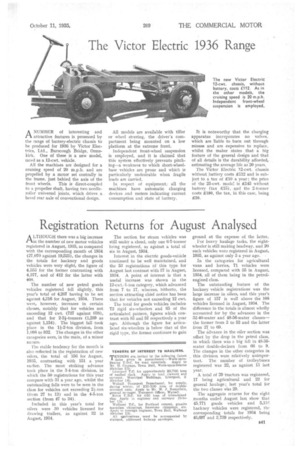The Victor Electric 1936 Range
Page 55

If you've noticed an error in this article please click here to report it so we can fix it.
A NUMBER of interesting and attractive features is possessed by the range of battery-electric chassis to be produced for 1936 by Victor Eleetries, Ltd., Burscough Bridge, Ormskirk. One of these is a new model, rated as a 12-cwt. vehicle.
All the machines are designed for a cruising speed of 20 m.p.h. and are propelled by a motor set centrally in the frame, just behind the axis of the front wheels. This is direct-coupled to a propeller shaft, having two needleroller universal joints, which drives a bevel rear aide of conventional design. All models are available with tiller or wheel steering, the driver's compartment being mounted on a low platform at the extreme front.
Independent front-wheel suspension is employed, and it is claimed that this system effectively prevents pitching—a weakness to which short-wheelbase vehicles are prone and which is particularly undesirable when fragile loads are carried.
In respect of equipment,all the machines have automatic charging devices and meters indicating current consumption and state of battery.
It is noteworthy that the charging apparatus incorporates no valves, which are liable to burn out through misuse and are expensive to replace, whilst the maker states that a big feature of the general design and that of all details is the durability afforded, estimating the average life as 20 years.
The Victor Electric 1.2-cwt. chassis without battery costs £112 and is subject to a tax of £10 a year ; the price of the 25-cwt. model is £145 without battery (tax £15), • and the 2-tonner costs £180, the tax, in this case, being £20.




























































































